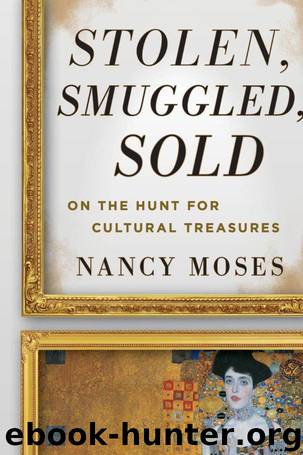Stolen, Smuggled, Sold: On the Hunt for Cultural Treasures by Nancy Moses

Author:Nancy Moses [Moses, Nancy]
Language: eng
Format: epub
Published: 2015-06-04T04:00:00+00:00
For virtually all of Egypt’s most illustrious pharaohs, this ultimate fear became a reality. Despite their best efforts to hide tombs in secure locations in the most inhospitable terrain, grave robbers have successfully looted tombs since antiquity: the draw of their treasures has been just too much to resist, especially in times of economic turmoil. By the time Western archaeologists arrived in the Valley of the Kings in the early 1800s, every tomb they found had been opened. In a number of cases, even the pharaoh himself, in the form of a mummy, was missing.[6]
This was Ramesses I’s fate. Within four hundred years of his burial, his eternal life fell victim to a wave of ancient tomb robbing. His tomb was penetrated, the gold and other valuables removed, and his sarcophagus violently pried open.
But nobody knew that Ramesses I was missing from his tomb until 1817, when an Italian circus strongman-turned-water engineer-turned-explorer named Giovanni Baptista Belzoni chanced by the entrance to Ramesses I’s tomb while touring the Valley of the Kings. Belzoni and his wife had come to Egypt to sell hydraulic irrigation machines to the Viceroy, but when that scheme failed, Belzoni was hired by British Consul Henry Salt to move colossal Egyptian monumental sculptures from their sandy resting places down the Nile and back to England. You might wonder why Egyptians were willing to let foreigners remove their precious cultural heritage, until you realize that the Egyptians were not in charge. At the time, Muhammad ‘Ali, the Viceroy of Egypt under the Ottoman Turks, was keenly aware of the economic and political potential of Egypt’s antiquities, so he offered Western nations permits to excavate ancient sites and allowed them to export obelisks.[7]
Belzoni was among the first to rediscover many tombs in the Valley of the Kings. On his second trip there in October 1817, he stumbled upon a small one. As he later wrote, “The appearance of the entrance indicated it would be a very large one, but it proved to be only the passage of one that was never finished.” This one belonged to Ramesses I.
If you would like to see Ramesses I’s tomb, it can be found on a website created by the Theban Mapping Project.[8] The address of the tomb is KV16. When I found it on the website, I opened a cross-section of Ramesses I’s tomb and imagined what it would have been like to join Belzoni in his discovery. I imagine standing next to him as he lights a torch and leads me down a long flight of stairs, a downward-sloping corridor, and another flight of stairs, the temperature dropping slightly as we descend. At the base is a small chamber dominated by a large red granite sarcophagus with a damaged lid. I imagine Belzoni holding his torch close to the wall as together we admire the beautiful figures with faces painted in profile.
“The painted figures on the wall are so perfect that they are the best adapted of any I ever saw to give a correct and clear idea of the Egyptian taste,”[9] Belzoni later wrote.
Download
This site does not store any files on its server. We only index and link to content provided by other sites. Please contact the content providers to delete copyright contents if any and email us, we'll remove relevant links or contents immediately.
Mindhunter: Inside the FBI's Elite Serial Crime Unit by John E. Douglas & Mark Olshaker(9201)
Wiseguy by Nicholas Pileggi(5671)
Room 212 by Kate Stewart(5037)
Hitman by Howie Carr(5019)
Secrecy World by Jake Bernstein(4646)
Killers of the Flower Moon: The Osage Murders and the Birth of the FBI by David Grann(4386)
Papillon (English) by Henri Charrière(4195)
Breaking Free by Rachel Jeffs(4175)
Killers of the Flower Moon by David Grann(3969)
Say Nothing by Patrick Radden Keefe(3903)
American Kingpin by Nick Bilton(3757)
The Secret Barrister by The Secret Barrister(3614)
Molly's Game: From Hollywood's Elite to Wall Street's Billionaire Boys Club, My High-Stakes Adventure in the World of Underground Poker by Molly Bloom(3486)
Mysteries by Colin Wilson(3397)
In Cold Blood by Truman Capote(3310)
Signature in the Cell: DNA and the Evidence for Intelligent Design by Stephen C. Meyer(3071)
I'll Be Gone in the Dark by Michelle McNamara(3024)
Rogue Trader by Leeson Nick(2977)
Bunk by Kevin Young(2949)
